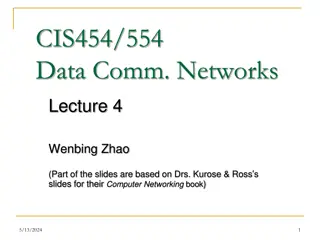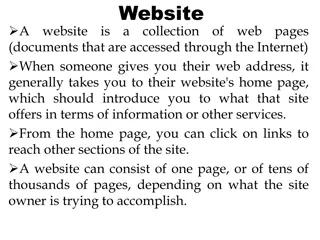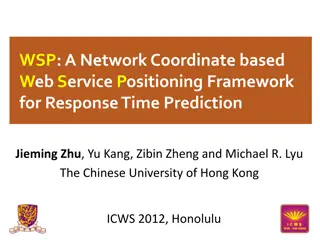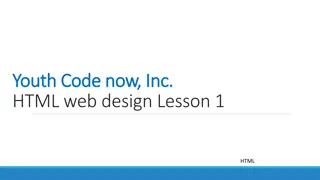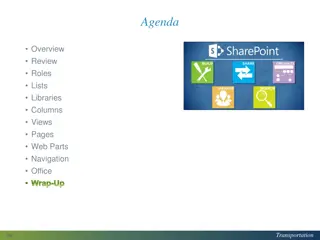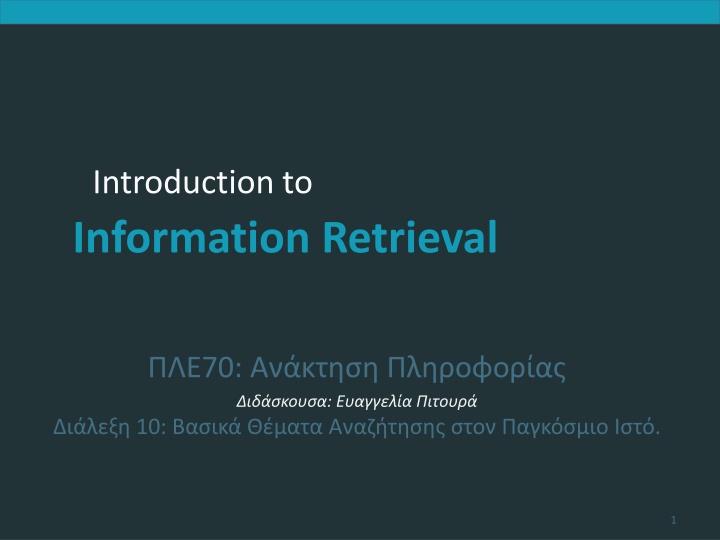
Introduction to Information Retrieval Examples and Applications
Explore the world of information retrieval with examples and applications covering spam detection, transactional searches, user intent, and query typing. Discover the nuances of search behavior and contextual understanding in information retrieval. Learn about spell correction, geographic context, and more to enhance your search experience.
Download Presentation

Please find below an Image/Link to download the presentation.
The content on the website is provided AS IS for your information and personal use only. It may not be sold, licensed, or shared on other websites without obtaining consent from the author. If you encounter any issues during the download, it is possible that the publisher has removed the file from their server.
You are allowed to download the files provided on this website for personal or commercial use, subject to the condition that they are used lawfully. All files are the property of their respective owners.
The content on the website is provided AS IS for your information and personal use only. It may not be sold, licensed, or shared on other websites without obtaining consent from the author.
E N D
Presentation Transcript
Introduction to Information Retrieval Introduction to Information Retrieval 70: : 10: . 1
. 19 Introduction to Information Retrieval ; Spam ; 2
. 19.4 Introduction to Information Retrieval 3
. 19.4.1 Introduction to Information Retrieval ; 2-3 4
. 19.4.1 Introduction to Information Retrieval Need [Brod02, RL04] Informational( ) (learn) (~40% / 65%) , , Low hemoglobin Navigational( ) (go) (~25% / 15%) , = 1 ( United Airlines) United Airlines 5
. 19.4.1 Introduction to Information Retrieval Transactional ( ) (do) ( web) (~35% / 20%) (Access a service) (Downloads) Seattle weather Mars surface images Canon S410 (Gray areas) Find a good hub Exploratory search see what s there Car rental Brasil 6
. 19.4.1 Introduction to Information Retrieval ; http://www.google.com/trends/hottrends power law 7
. 19.4.1 Introduction to Information Retrieval ( ) / , , ( ) / 8
Introduction to Information Retrieval (Source: iprospect.com WhitePaper_2006_SearchEngineUserBehavior.pdf) 9
Introduction to Information Retrieval (intent) ; Guess user intent independent of context: Spell correction Precomputed typing of queries Better: Guess user intent based on context: Geographic context (slide after next) Context of user in this session (e.g., previous query) Context provided by personal profile (Yahoo/MSN do this, Google claims it doesn t) 10
Introduction to Information Retrieval Examples of Typing Queries Calculation: 5+4 Unit conversion: 1 kg in pounds Currency conversion: 1 euro in kronor Tracking number: 8167 2278 6764 Flight info: LH 454 Area code: 650 Map: columbus oh Stock price: msft Albums/movies etc: coldplay 11
Introduction to Information Retrieval Geographical Context Three relevant locations 1. Server (nytimes.com New York) 2. Web page (nytimes.com article about Albania) 3. User (located in Palo Alto) Locating the user IP address Information provided by user (e.g., in user profile) Mobile phone Geo-tagging: Parse text and identify the coordinates of the geographic entities Example: East Palo Alto CA Latitude: 37.47 N, Longitude: 122.14 W Important NLP problem 12
Introduction to Information Retrieval Geographical Context How to use context to modify query results: Result restriction: Don t consider inappropriate results For user on google.fr only show .fr results Ranking modulation: use a rough generic ranking, rerank based on personal context Contextualization / personalization is an area of search with a lot of potential for improvement. 13
Introduction to Information Retrieval Relevance and validity of results Precision at 1? Precision above the fold? Comprehensiveness must be able to deal with obscure queries Recall matters when the number of matches is very small UI (User Interface) Simple, no clutter, error tolerant No annoyances: pop-ups, etc. Trust Results are objective Coverage of topics for polysemic queries Diversity, duplicate elimination 14
Introduction to Information Retrieval Pre/Post process tools provided Mitigate user errors (auto spell check, search assist, ) Explicit: Search within results, more like this, refine ... Anticipative: related searches Deal with idiosyncrasies Web specific vocabulary Impact on stemming, spell-check, etc. Web addresses typed in the search box 15
. 19.3 Introduction to Information Retrieval 16
Introduction to Information Retrieval Ads Graphical graph banners on popular web sites (branding) cost per mil (CPM) model: the cost of having its banner advertisement displayed 1000 times (also known as impressions) cost per click (CPC) model: number of clicks on the advertisement (leads to a web page set up to make a purchase) brand promotion vs transaction-oriented advertising 17
Introduction to Information Retrieval Brief (non-technical) history Early keyword-based engines ca. 1995-1997 Altavista, Excite, Infoseek, Inktomi, Lycos Paid search ranking: Goto (morphed into Overture.com Yahoo!) Your search ranking depended on how much you paid Auction for keywords: casino was expensive! 18
Introduction to Information Retrieval Ads in Goto In response to the query q, Goto return the pages of all advertisers who bid for q, ordered by their bids. when the user clicked on one of the returned results, the corresponding advertiser payment to Goto Initially, payment equal to bid for q Sponsored search or Search advertising 19
Introduction to Information Retrieval Ads in Goto 20
Introduction to Information Retrieval Ads Provide pure search results (generally known as algorithmic or organic search results) as the primary response to a user s search, together with sponsored search results displayed separately and distinctively to the right of the algorithmic results. 21
Introduction to Information Retrieval Paid Search Ads Algorithmic results. 22
Introduction to Information Retrieval Ads Search Engine Marketing (SEM) Understanding how search engines do ranking and how to allocate marketing campaign budgets to different keywords and to different sponsored search engines Click spam: clicks on sponsored search results that are not from bona fide search users. For instance, a devious advertiser 23
Introduction to Information Retrieval Ads Paid inclusion: pay to have one s web page included in the search engine s index Different search engines have different policies on whether to allow paid inclusion, and whether such a payment has any effect on ranking in search results. Similar problems with TV/newspapers 24
Introduction to Information Retrieval How are ads ranked? Advertisers bid for keywords sale by auction. Open system: Anybody can participate and bid on keywords. Advertisers are only charged when somebody clicks on their ad. Important area for search engines computational advertising. an additional fraction of a cent from each ad means billions of additional revenue for the search engine. 25
Introduction to Information Retrieval How are ads ranked? How does the auction determine an ad s rank and the price paid for the ad? Basis is a second price auction 26
Introduction to Information Retrieval Google s second price auction bid: maximum bid for a click by advertiser CTR: click-through rate: when an ad is displayed, what percentage of time do users click on it? CTR is a measure of relevance. ad rank: bid CTR: this trades off (i) how much money the advertiser is willing to pay against (ii) how relevant the ad is rank: rank in auction paid: second price auction price paid by advertiser 27
Introduction to Information Retrieval Google s second price auction Second price auction: The advertiser pays the minimum amount necessary to maintain their position in the auction (plus 1 cent). price1 CTR1 = bid2 CTR2 (this will result in rank1=rank2) price1= bid2 CTR2/ CTR1 p1 = bid2 CTR2/CTR1 = 3.00 0.03/0.06 = 1.50 p2 = bid3 CTR3/CTR2 = 1.00 0.08/0.03 = 2.67 p3 = bid4 CTR4/CTR3 = 4.00 0.01/0.08 = 0.50 28
Introduction to Information Retrieval Keywords with high bids According to http://www.cwire.org/highest-paying-search-terms/ $69.1 mesothelioma treatment options $65.9 personal injury lawyer michigan $62.6 student loans consolidation $61.4 car accident attorney los angeles $59.4 online car insurance quotes $59.4 arizona dui lawyer $46.4 asbestos cancer $40.1 home equity line of credit $39.8 life insurance quotes $39.2 refinancing $38.7 equity line of credit $38.0 lasik eye surgery new york city $37.0 2nd mortgage $35.9 free car insurance quote 29
Introduction to Information Retrieval Search ads: A win-win-win? The search engine company gets revenue every time somebody clicks on an ad. The user only clicks on an ad if they are interested in the ad. Search engines punish misleading and nonrelevant ads. As a result, users are often satisfied with what they find after clicking on an ad. The advertiser finds new customers in a cost-effective way. 31
Introduction to Information Retrieval Not a win-win-win: Keyword arbitrage Buy a keyword on Google Then redirect traffic to a third party that is paying much more than you are paying Google. E.g., redirect to a page full of ads This rarely makes sense for the user. Ad spammers keep inventing new tricks. The search engines need time to catch up with them. 32 32
Introduction to Information Retrieval Not a win-win-win: Violation of trademarks Example: geico During part of 2005: The search term geico on Google was bought by competitors. Geico lost this case in the United States. Louis Vuitton lost similar case in Europe (2010). It s potentially misleading to users to trigger an ad off of a trademark if the user can t buy the product on the site. 33
Introduction to Information Retrieval SPAM (SEARCH ENGINE OPTIMIZATION) 34
. 19.2.2 Introduction to Information Retrieval The trouble with paid search ads It costs money. What s the alternative? Search Engine Optimization (SEO): Tuning your web page to rank highly in the algorithmic search results for select keywords Alternative to paying for placement Thus, intrinsically a marketing function Performed by companies, webmasters and consultants ( Search engine optimizers ) for their clients Some perfectly legitimate, some very shady 35
. 19.2.2 Introduction to Information Retrieval tf/idf maui resort maui resort SEOs . ., mauiresort maui resort maui resort , background crawlers browsers 36
. 19.2.2 Introduction to Information Retrieval keyword stuffing a web page loaded with keywords in the meta tags or in content of a web page (outdated) meta-tags, Hidden text with colors, position text behind the image, style sheet tricks, etc. Meta-Tags = London hotels, hotel, holiday inn, hilton, discount, booking, reservation, sex, mp3, britney spears, viagra, 37
. 19.2.2 Introduction to Information Retrieval Cloaking ( ) (search engine spider) browser DNS cloaking: Switch IP address. Impersonate SPAM N Is this a Search Engine spider? Real Doc Y Cloaking 38
. 19.2.2 Introduction to Information Retrieval (spam) Doorway pages Pages optimized for a single keyword that re-direct to the real target page If a visitor clicks through to a typical doorway page from a search engine results page, redirected with a fast Meta refresh command to another page. Lander page: optimized for a single keyword or a misspelled domain name, designed to attract surfers who will then click on ads 39
. 19.2.2 Introduction to Information Retrieval (spam) Link spamming Mutual admiration societies, hidden links, awards Domain flooding: numerous domains that point or re- direct to a target page Pay somebody to put your link on their highly ranked page Leave comments that include the link on blogs Robots (bots) Fake query stream rank checking programs Curve-fit ranking programs of search engines Millions of submissions via Add-Url 40
Introduction to Information Retrieval The war against spam Quality signals - Prefer authoritative pages based on: Votes from authors (linkage signals) Votes from users (usage signals) Policing of URL submissions Anti robot test Limits on meta-keywords Robust link analysis Ignore statistically implausible linkage (or text) Use link analysis to detect spammers (guilt by association) Spam recognition by machine learning Training set based on known spam Family friendly filters Linguistic analysis, general classification techniques, etc. For images: flesh tone detectors, source text analysis, etc. Editorial intervention Blacklists Top queries audited Complaints addressed Suspect pattern detection 41
Introduction to Information Retrieval More on spam Web search engines have policies on SEO practices they tolerate/block http://help.yahoo.com/help/us/ysearch/index.html http://www.google.com/intl/en/webmasters/ Adversarial IR ( ): the unending (technical) battle between SEO s and web search engines Research http://airweb.cse.lehigh.edu/ Check out: Webmaster Tools (Google) 42
Introduction to Information Retrieval SIZE OF THE WEB 43
. 19.5 Introduction to Information Retrieval web ? , web Dynamic content, e.g., calendars Soft 404: www.yahoo.com/<anything> is a valid page Static web contains syntactic duplication, mostly due to mirroring (~30%) Some servers are seldom connected ; Media, and consequently the user crawl - . 44
. 19.5 Introduction to Information Retrieval ; The notion of a page being indexed is still reasonably well defined. Already there are problems Document extension: e.g., engines index pages not yet crawled, by indexing anchortext. Document restriction: All engines restrict what is indexed (first n words, only relevant words, etc.) Multi-tier indexes (access only top-levels) 45
. 19.5 Introduction to Information Retrieval New definition? The statically indexable web is whatever search engines index. IQ is whatever the IQ tests measure. Different engines have different preferences max url depth, max count/host, anti-spam rules, priority rules, etc. Different engines index different things under the same URL: frames, meta-keywords, document restrictions, document extensions, ... 46
. 19.5 Introduction to Information Retrieval Relative Size from Overlap Given two engines A and B 1. 2. Sample URLs randomly from A Check if contained in B and vice versa A B A B= (1/2) * Size A A B= (1/6) * Size B (1/2)*Size A = (1/6)*Size B Size A / Size B = (1/6)/(1/2) = 1/3 Each test involves: (i) Sampling (ii) Checking 47
. 19.5 Introduction to Information Retrieval (Sampling) URLs Ideal strategy: Generate a random URL Problem: Random URLs are hard to find (and sampling distribution should reflect user interest ) Approach 1: Random walks / IP addresses In theory: might give us a true estimate of the size of the web (as opposed to just relative sizes of indexes) Approach 2: Generate a random URL contained in a given engine Suffices for accurate estimation of relative size 48
. 19.5 Introduction to Information Retrieval Statistical methods 1. Random queries 2. Random searches 3. Random IP addresses 4. Random walks 49
. 19.5 Introduction to Information Retrieval Random URLs from random queries 1. Generate random query: how? Not an English dictionary Lexicon:400,000+ words from a web crawl Conjunctive Queries: w1 and w2 e.g., vocalists AND rsi 2. Get 100 result URLs from engine A 3. Choose a random URL as the candidate to check for presence in engine B This distribution induces a probability weight W(p) for each page. 50

